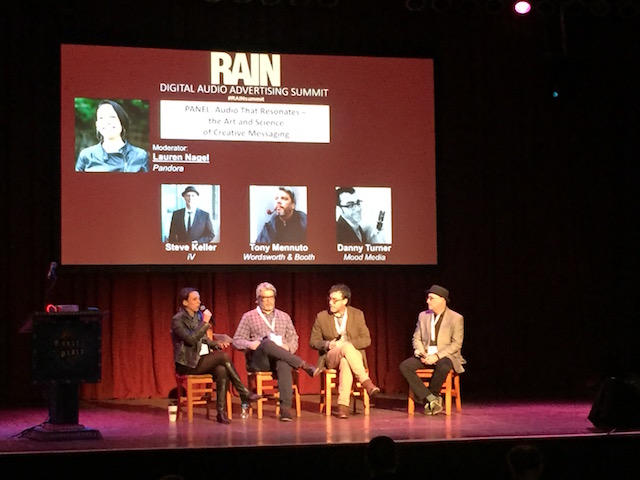 RAIN’s Digital Audio Advertising Summit in Chicago kicked off with a discussion of creative messaging. Lauren Nagel, Pandora Media’s group creative director, guided an insightful conversation with three experts:
RAIN’s Digital Audio Advertising Summit in Chicago kicked off with a discussion of creative messaging. Lauren Nagel, Pandora Media’s group creative director, guided an insightful conversation with three experts:
- Tony Menuto, President of Wordsworth & Booth at Horizon Media
- Steve Keller, CEO/Strategist at iV
- Danny Turner, Global Senior Vice President of Programming & Production at Mood Media
All three agreed that developments in media technology are helping advertisers realize that audio is worthy of its own strategy. Tony Menuto said he’s noticed a shift in mindset, with many advertisers realizing that they can’t just adapting existing broadcast ideas into an audio track and get results. But they still have some preconceptions to break down.
“Not paying attention to it” was one of Menuto’s answers when asked what advertisers’ biggest mistakes are for the audio field. And there’s still progress to be made in teaching advertisers just how many details go into an audio spot. “So many times people want to begin the conversation with music,” said Danny Turner. But a song isn’t necessarily going to be an accurate reflection of a brand’s audio identity. Steve Keller said that most agency processes don’t put a high priority on audio components, leaving them to the last minute rather than putting those discussions in the early brainstorming stage.
Audio identity stood out as a central argument of the discussion. Keller emphasized the need to treat audio as “an extension of brand meaning and value.” Building an audio signature that incorporates everything from the sound effects to the voiceover talent, not just the background music or jingle. Setting those signifiers early on and keeping them consistent makes the messaging more powerful.
While personalization is one of the buzzier words for digital audio these days, Turner did advise setting parameters in how and what control is turned over to a casual listener. “Otherwise you’re just acquiesing brand control,” he said. Keller suggested thinking about macro-level personalization rather than micro-level. “I think machine learning is going to change this landscape sooner than we think,” he said.
“What we’re collectively saying very loudly is: informed curation matters,” Turner said. All three speakers highlighted the importance of data collection in both convincing ad clients of what will succeed in audio, technology has allowed more paths for gathering hard numbers about what will work. And some of the relevant research goes beyond just ROI or A/B testing. Keller cited an example verging on voodoo, mentioning research that showed the music someone listens to while eating can make their food taste spicier. With this volume and depth of research available, brands can be more creative in how they engage with different listeners in the audio space.

One powerful element that is consistently being left out of audio-only advertising is the use of the listener’s visual imagination. Imagination means literally to create images in the mind. Audio-only advertising can do this far better than any other medium.
The most successful writers are those who use situations and SFX to project an image on the screen of the listener’s imagination, because the images that form in the mind are images from that listener’s own experience. In that way, imagination-based spots potentially have far better retention than spots that rely on dry facts over insipid stock music. Or worse yet, voice alone reciting a litany of product benefits.
I challenge the writers of streaming advertising to bring the Theater of the Mind concept of storytelling back to audio advertising. Right now, it’s a pretty dry landscape.